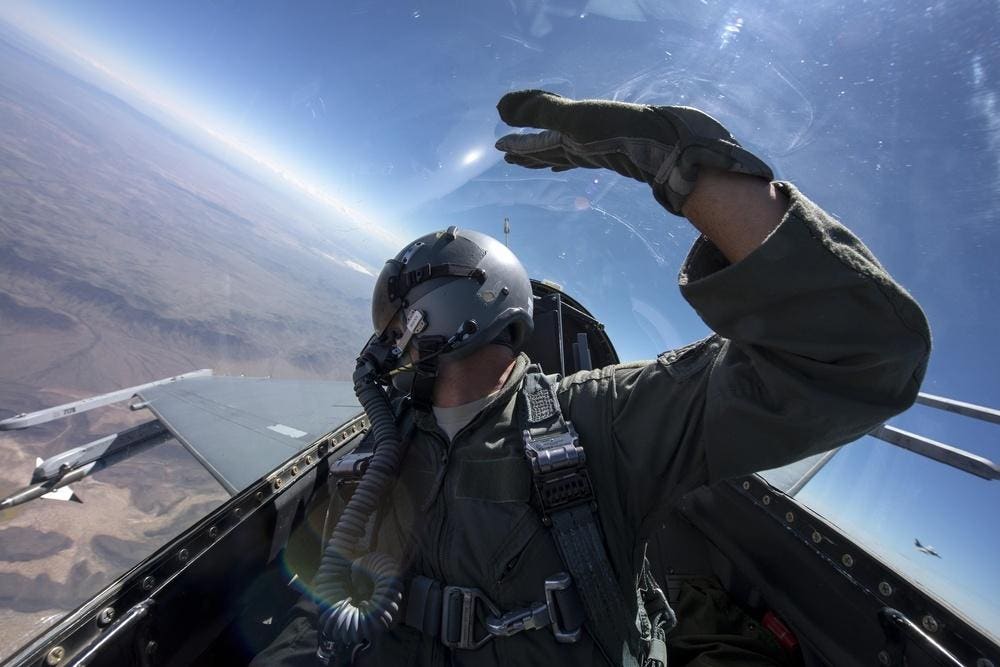The likelihood that the U.S. would train Ukrainian pilots to fly F-16s in America was always high. Last week, the Pentagon confirmed they’re coming to Arizona this fall.
Pentagon Press Secretary Brig. Gen. Pat Ryder (USAF) briefed reporters that “several” Ukranian pilots and “dozens” of maintainers will be trained by the Arizona Air National Guard’s 162nd Wing beginning sometime in September.
The lack of specific numbers stems in part from a determination that the Netherlands and Denmark (NATO leads for the F-16 transfer) have reached training capacity and that the U.S. will take up the slack according to Ryder.
In connection with the announcement, Defense News cited an email from an unnamed Air Force official asserting that pilots without prior flight experience could learn to fly the F-16 in about eight months. Ukrainian pilots who have previous experience flying other fighters could learn to fly the airplane in about five months under the Air Force’s transition qualification track.
Aside from the timeline, the email raises the possibility that some of the those being trained to fly the F-16 may not be qualified fighter pilots, coming from other type-model lines or roles within the Ukranian Air Force (UAF).
Such a possibility would speak to the practical need to keep some UAF line pilots in place to meet the country’s air defense needs and to the pool of individuals actually available to undertake training in the first place.
It also reflects on American priorities given that the U.S. Air Force is currently not able to meet its own pilot training production goals. Dedicating existing F-16 training capacity to Ukrainian pilots/maintainers arguably comes with opportunity-cost to the USAF, even if the 162nd Wing is noted for its international role.
I’ve written previously about the likelihood that Ukrainian pilots would train in the U.S. – and the possibility that a number have already trained, moving beyond the “evaluation” that they were reported to be undergoing early this year.
While there has been no confirmation of this, the recent news that Ukraine will begin receiving surplus Norwegian F-16s as well as the ex-Dutch and Danish Vipers that have been pledged (putting its total number potentially well over 60) suggests that pilot/maintainer training may well have gotten a head start.
The Air National Guard’s 162nd Wing, based adjacent to Tucson International Airport (at Morris Air National Guard Base), operates four squadrons with about 70-80 F-16s and has extensive experience in training foreign military sales (FMS) customers to operate the airplane.
As far back as the late 1980s, the Wing hosted and trained Dutch air force pilots to fly the F-16 and by the mid 1990s, it was the designated U.S. international training unit for the Viper. In the decades that have followed, the 162nd has trained the majority of foreign F-16 aircrews from European to Asian operators, totaling pilots from 25 countries.
But the Wing does not simply host foreign students in Tucson. It also conducts training in individual client nations. The 162nd’s mobile training teams have conducted classes in numerous countries around the world including Poland.
NATO-member Romania operates older F-16s and the U.S. Air Force is already operating F-16s in an air-policing role from Mihail Kogalniceanu military base in the eastern part of the country. Sending a 162nd mobile training team there to train Ukrainian pilots might be logistically workable though speedier training is more apt to be realized in Arizona.
Another option for training Ukrainian pilots in the U.S. lies in the possibility of instruction by one or more of the many private “Red Air” adversary companies now in business domestically.
A private adversary company would need clearance from DoD and the U.S. State Department to provide Ukraine with training services but that could be obtained if the political will was there. The cadre of highly experienced instructor pilots (many with previous USAF Weapons School tours) that these firms have could readily take on such training.
However, it’s unlikely for now according to a source within the Red Air industry with whom I spoke today.
Given the green light, the Air Force will be eager to do the job itself my source asserted. Despite its own pilot training shortfalls, teaching Ukrainian pilots to fly the Viper is a “sexy” tasking, one those executing it would much rather keep to themselves, burnishing their own resumes (performance reports) and career prospects for the future.
Handing the job to private Red Air companies like nearby Mesa, Arizona-based, Top Aces (which now operates a fleet of 29-plus ex-Israeli F-16A/Bs equipped with the company’s Advanced Aggressor Mission System which includes an AESA radar) is not a move the Air Force would gladly make, at least in the short term.
The training timelines mentioned above suggest Air Force-trained Ukrainian F-16 pilots could be ready to fly by late February or March. As I’ve previously noted, that could mean the UAF has trained Viper pilots (at least capable of minimally employing the fighter) before it actually has F-16s. The timing of these components – including standing-up a trained maintenance cadre – will be interesting to watch.
What weapons the UAF will field on its F-16s will bear a close watch as well. Cruise missiles and other air-to-surface strike missiles (including sea-strike variants) are at the top of the Ukrainians’ list. But training Ukrainian pilots here in America was on the cards from the moment Ukrainian President Volodymyr Zelensky brought up the idea of obtaining F-16s in 2022.
Read the full article here





